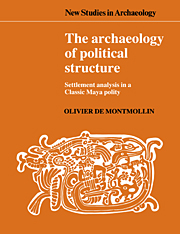Book contents
- Frontmatter
- Contents
- List of figures
- List of tables
- Preface
- 1 Studying ancient complex polities
- 2 Thinking about Maya political structure
- 3 The Rosario polity
- 4 Linking Maya politics and settlement
- 5 Centralization
- 6 Differentiation and integration
- 7 Political regimes and microcosms
- 8 Political stratification patterns
- 9 Mechanical versus organic solidarity
- 10 Segmenting versus non-segmenting organization
- 11 Archaeological study of Maya polities
- Notes
- References
- Index
7 - Political regimes and microcosms
Published online by Cambridge University Press: 29 March 2010
- Frontmatter
- Contents
- List of figures
- List of tables
- Preface
- 1 Studying ancient complex polities
- 2 Thinking about Maya political structure
- 3 The Rosario polity
- 4 Linking Maya politics and settlement
- 5 Centralization
- 6 Differentiation and integration
- 7 Political regimes and microcosms
- 8 Political stratification patterns
- 9 Mechanical versus organic solidarity
- 10 Segmenting versus non-segmenting organization
- 11 Archaeological study of Maya polities
- Notes
- References
- Index
Summary
Pyramidal versus hierarchical regimes
The continuum between pyramidal and hierarchical political regimes deals with both the decision-making and decision-implementing aspects of a political system. The practical reason for treating these aspects jointly is that archaeological evidence in the Rosario Valley does not allow anything like a distinction between policymaking (politics) and policy-implementation (administration or bureaucracy) to be made. There are no executive buildings and artifacts as opposed to administrative buildings and artifacts. Taking the argument onto a more interpretive plane, Maya ethnohistoric sources suggest that in the Postclassic Period there were no clearly separable groups of people involved in policy-making as opposed to policyimplementation (with the exception of menial administrative “flunkies ” such as the tupiles mentioned in a few Yucatec sources). More precisely, this assertion is based on an ethnohistorical survey covering a variety of Contact Period Maya polities (the Yucatec Maya-de Montmollin 1980; the Guatemala Highland Quiche Mayade Montmollin 1982b; and the Chiapas Highland Maya-de Montmollin 1979c). Once again applying historical-evolutionary logic, one would not expect earlier periods to feature fully professional bureaucratic structures (after Weber, see Gerth and Mills eds. 1946: ch. 8). This logic is a form of substantivism applied to politics instead of economics. It resembles Giddens' discontinuist perspective on the development of the state, one which draws a sharp contrast in terms of bureaucratic structure and efficacy between traditional states and modern nation-states (Giddens 1985). Thus, the lack of evidence for pure administrators or bureaucrats in the Rosario Valley polity may be taken to reflect a genuine absence of such specialized personnel.
- Type
- Chapter
- Information
- The Archaeology of Political StructureSettlement Analysis in a Classic Maya Polity, pp. 140 - 172Publisher: Cambridge University PressPrint publication year: 1989



